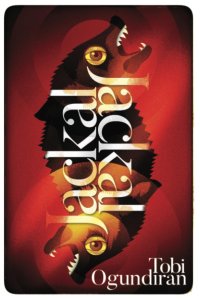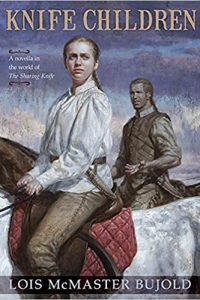Paul Di Filippo Reviews Jackal, Jackal by Tobi Ogundiran
 Jackal, Jackal, Tobi Ogundiran (Undertow Publications 978-1988964430, trade paperback, 318pp, $19.99) July 2023
Jackal, Jackal, Tobi Ogundiran (Undertow Publications 978-1988964430, trade paperback, 318pp, $19.99) July 2023
Well do I recall the birth of Undertow Publications in 2009. Right from the start, they manifested themselves as a classy, uncompromising, smartly curated firm. Now, scores of books later, that presentation remains a reality. (Curiously enough, they have published only one original novel since then—Mary Rickert’s The Shipbuilder of Bellfairie, in this manner concentrating on the support of the undervalued genres of theme anthologies and one-author story collections.) Their latest offering is yet another high-quality assemblage of tales, from the young (born 1995) Nigerian writer Tobi Ogundiran. It’s his first book, and a proud, confident debut.
Nearly all these stories feature, to varying degrees, African cultural motifs and characters born in that region of the world. Even those tales set in plainly subcreated worlds resonate with Africa. And yet, as with all the best fiction, they cloak universals beneath their finely limned particulars.
Ogundiran already possesses a mature, assured style and voice. And while he often veers into territory that borders on magical realism and fables, just as often he gives us something more naturalistic that might have come, mutatis mutandis, from the pen of Saki or Dahl, Aickman or M. R. James.
Let’s take a stroll through these worlds.
“The Tale of Jaja and Canti” concerns a crafted wooden man given life by an ethereal being known as a “canti.” His subsequent life becomes a quest for his benefactor, and he earns a happy release. The gentle nature of this narrative stands at odds with the majority of these stories, in which our heroes and heroines often meet gruesome endings, deserved or not. Ogundiran can be as mercilessly macabre as any of his peers.
Any true reader is a librarian-ophile. But “The Lady of the Yellow-Painted Library” will give one pause in their devotion, as the titular demiurge seeks vengeance for an overdue book.
Original to this collection, “Jackal, Jackal” has great grim fun with the motif of a mask that changes the wearer. “This jackal is my real face. This is who I have always been…”
There’s a kind of Vancian quality to “The Epic of Qu Shittu”, wherein a trespasser onboard a mysterious ship encounters “Qu Shittu the Terrible, demon spawn of Iku, master of magicks and terror of kings.” It’s a lesson in being careful about what you desire.
An abiku is a spirit child, warped from birth by otherworldly influences. “The Many Lives of an Abiku” reveals how one such being yearned for mortal existence and won through—but not without immense costs to her and her family.
“Isn’t Your Daughter Such a Doll” gives us little Celine and her living doll Ralia. But the relationship between artifact and human is not what we at first believe, and both will end up transformed.
Surely the shade of Poe haunts “The Muse of Palm House”. A decaying mansion, a vampiric nude woman, and a confusion between psyche and reality conduce towards a classic Usher incident.
Ogundiran explains—in entrancing story notes—that “Here Sits His Ignominy” was his one and only attempt at flash fiction. He succeeded admirably, telling us evocatively about the undoing of a would-be conqueror.
Torch singer Bisi has a young son under the care of the boy’s grandmother. But Bisi’s career comes first—until her indifference to the boy results in a kind of Invasion of the Body Snatchers moment. Thus: “Lágbájá”.
Ogundiran takes the Westerner legend of the Marie Celeste ghost ship and marries it perfectly to the maritime culture of Nigeria in “Maria’s Children”. Needless to say, any encounter with the ship will not bode well for the young children who dare it.
“Faêl” has “fae” within it, and this tale suitably reads like High Fantasy.
But that was long ago, before the witch-king and the War of Erinle. That was when there had been three moons to light the night and a white sun to brighten the day. The moons were long destroyed and the sun did not deign to show her face. All that was left were memories and the sharp taste of salt in the back of his throat.
A bloodraven flew out of the mists, cawing and flapping, its talons reaching for his neck. Sùr seized the beast, and with a lazy flick of his hand snapped its neck. He tossed the bird into the canal, watching it sink until it vanished from sight. How many necks had he snapped like that? How many people had he killed? Sùr grimaced as the pain lanced up his spine and into the base of his skull. No. No use thinking about it. He forced himself to smile, breathing through his teeth as the pain subsided. His hand moved involuntarily into his pockets, reaching for the flask and the relief it held. He stopped himself just in time. It was a bad habit, one cultivated over a thousand years. But he had made his choice. He wouldn’t. Not anymore.
Asâhake seems the lowliest of acolytes in her strict religious order. And yet it is her destiny to see what others cannot, even unto becoming “Guardian of the Gods”.
Young Dele is missing his dead father, and so takes up the pursuit of the talking drum as relief and a connection to the man. But accidentally summoning up ghosts leads to cosmic complications in “Drummer Boy in a World of Wise Men”.
Just as in the first story, Ogundiran, in “Deep in the Gardener’s Barrow”, plays with a Western fairytale: this time, Hansel and Gretel. Iná and Tofi encounter Tatuba the Forest Witch, and their fate teeters twixt slaughter and escape.
The most anomalous tale, our second unpublished instance, “Midnight in Moscow” boasts a Russian setting, and charts the path of the Nigerian visitor Midnight as he encounters the classic Baba Yaga.
There’s almost a Graham Joyce feel to “In the Smile Place”, as an older brother must resolve his bad karma with his younger sibling, whom he once left to the mercies of the Long Man.
There’s plenty of tragedy in “The Clockmaker and His Daughter”—sickness, dictatorship, betrayal—but a hopeful ending for the bereaved watchmaker offers a beneficent climax.
Ogundiran reveals his final tale to be his stab at a Lovecraftian Mythos story, and “The Goatkeeper’s Harvest” does indeed offer some primo HPL vibes.
Eight feet tall, dressed in a black dress which snaps about her hooves. Her goat head grows into what should be a woman’s body, but is something else. A mockery. An aberration. And though she’s several feet from me, I know she is looking at me.
As I watch, black spectral wings unfurl like sails behind her to form a canopy over the gathering goats at her feet. The goats, where they were skinny and emaciated when they stole into my barn, are now robust, fur-coats shiny, eyes bright with hunger. They simply stand there. Waiting.
Ogundiran’s career between book covers is off to a fantabulous start. This volume presages many fine stories to come, and should find its way to various award ballots soon.
 While you are here, please take a moment to support Locus with a one-time or recurring donation. We rely on reader donations to keep the magazine and site going, and would like to keep the site paywall free, but WE NEED YOUR FINANCIAL SUPPORT to continue quality coverage of the science fiction and fantasy field.
While you are here, please take a moment to support Locus with a one-time or recurring donation. We rely on reader donations to keep the magazine and site going, and would like to keep the site paywall free, but WE NEED YOUR FINANCIAL SUPPORT to continue quality coverage of the science fiction and fantasy field.
©Locus Magazine. Copyrighted material may not be republished without permission of LSFF.







